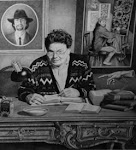The next letter to Grace is dated 15 December 1958. What
happened in that long gap from the end of May? Brett Millier has very little to
say about this year in Bishop’s life. With the publication of The Diary of ‘Helena Morley’ in December
1957, Millier more or less leaps to 1960, which saw Bishop make her first trip
down the Amazon. One Art: Elizabeth
Bishop Letters includes only seven letters (and part of an eighth) during
this late May to mid-December period. And then this 15 December letter to Grace.*
Why Robert Giroux chose this letter, a short, utilitarian epistle, is puzzling
unless there are few extant letters overall for this year, so it was necessary
in order to bulk it up.
What is immediately obvious, and amusing when you think
about it, is that Grace had been on the move all year. Bishop couldn’t keep
track of her. Indeed, Aunt Grace was far more peripatetic at this time than her
niece. Perhaps 1958 and 1959 were the most settled and domestic years of
Bishop’s entire Brazilian sojourn.
Bishop’s letter was triggered by receiving “your card a few
days ago.” Bishop supposed a letter from Grace “got lost” because she confessed
that “I didn’t know you were going any place!” Bishop had already sent Grace “a
card and Christmas gift” (undoubtedly, the usual money), and hoped that the
folks at the farm in Great
Village would forward it
to her, wherever that might be. Bishop speculated that perhaps her aunt was
with Aunt Mary, but then thought better of that and said, “I think you must be
spending Christmas with Roddy” (Grace’s youngest son who lived in Brantford, Ontario,
Canada): “I’ll send it [“this note”] there.” All this confusion and
uncertainty was, in Bishop’s view, caused by the postal service, “The mails are
getting worse and worse, obviously. I rarely lost anything until the past
year.”
After typing the above sentence, Bishop inserted a “//” —
signaling a seemingly right angle change of subject: “How I wish we had some
more of that delicious venison you once sent us — and maple syrup.” Where did
that come from? But you can see why Bishop made the leap, remembering the gifts
Grace had sent in the past, but would no longer be able to trust to the
worsening postal system: “but it is out of the question now to send anything at
all, in or out.” Bishop reported to Grace that the customs service was
“supposedly” being “reorganized,”
something Bishop hoped would be done “in a few months,” so that they could
“begin again” to exchange more than just letters.
One of the subjects of Grace’s now lost letter was clearly
about what the weather was like and what Bishop’s Christmas would entail, which
prompted a detailed report. After the reprieve of a relatively cool winter at
Samambaia, summer had arrived, bringing “the hottest November in 33 years —
around 104 in Rio most of the time. (That is
HOT.)” At Samambaia “it never gets like that,” but even so, the temperature was
higher than normal. This prompted much swimming “in our pool every day.” Bishop
was also “making sherberts all the time,” from the abundant “wonderful
pineapples, mangoes, etc.” that were available. The extreme heat in Rio also meant that they had lots of company, people
escaping the oppressive weather.
As for their Christmas holiday, Bishop tells Grace that “on
the 22nd we are going away to Cabo Frio (‘cold cape’) for ten days.” Bishop and
Lota had gone there for the first time the Christmas before and would continue
this holiday getaway for the next several years. Friends “have a nice house
there, on the beach.” It was a place to fish and swim and had “beautiful
scenery.” Part of the motivation for this getaway was to give “the maids a rest
from us and us from them.”
Bishop explained that when they stayed at home for Christmas
they actually “have a tree, of sorts.” Bishop refers to this “tropical plant”
as a “graveta.” And offers a vivid description: “it’s a huge things, six
or eight feet high, dark red, waxy, with yellow blossoms at the tips, and
shaped like a Christmas tree, more or less — anyway, with candles it is very
striking, and we usually send a boy up the cliffs to cut us the biggest one he
can find (we located one through binoculars one year!).” As exotic as this
probably sounded to Grace, Bishop concluded that the whole thing “isn’t
Christmassy at all.” If she couldn’t have a northern holiday, Bishop clearly
was happy with a Christmas Day “swimming and lying in hammocks….”
Their contribution to the feast was ham, which they would
“bake and decorate … there,” and “chocolate cake and tins of cookies.”
Before signing off, Bishop couldn’t help but tell the
still-practicing nurse that she had been administering “whooping-cough shots”
to the maids’ children, and wished she “give them both Salk shots, too.” But
she was not able to get the serum.
The wanderer turned home-body Bishop closed her letter
declaring, “I don’t like to think of you traipsing around in the freezing
cold.” And wondering just where Brantford
was, “I must look at a map.” Appealing once more for her aunt to “write me all
your doings, much more interesting than mine,” she urged Grace “to take care of
yourself” and “have a good time.” Ending with her usual, “With much love.”
The next post offers an account of that holiday in Cabo
Frio.
***********
*Note: One Art:
Elizabeth Bishop Letters includes ten letters to Grace (in whole or in part
— one is a mere fragment). The dates of these letters are: 5 July 1956; 19 October 1956; 2 December 1956; 16 September 1957; 15
December 1958; 15 or 16 November 1959; 3 September 1960; 26 July 1961; 26
August 1961; 12 December 1961.
















